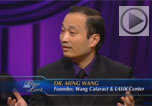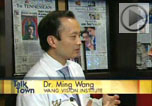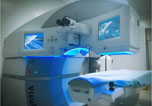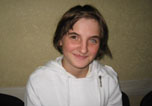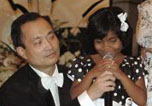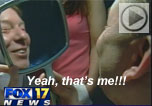- Over 55,000 LASIK and cataract procedures (including on over 4,000 doctors)
- The FIRST center in TN to offer Laser Cataract Surgery
- Introduced bladeless all-laser LASIK to the state
- Implanted the state's first FOREVER YOUNG™ Lens
- The first surgeons in the US to perform a new Intacs surgery to treat keratoconus
- Helped patients from 40 states and 55 countries
- International referral center for cataract surgery and LASIK complications
- Read Dr. Wang's book: LASIK Vision Correction
Why did you decide to have LASIK? Why did you choose Dr. Wang? How has your life changed since your LASIK procedure?
What is your advice for people considering LASIK?
Click to read more
| Article Library | Print This Page |
Of Eyes and Elegance - Scenes from Nashville Starz
Nashville eye surgeon Dr. Ming Wang leads a new wave of interest in classical ballroom dancing Header
Wang Vision 3D Cataract and LASIK Center, Nashville, Tennessee
At the recent Nashville Statz ballroom dance competition, one of the top 10 ballroom dance championships in US, which took place in Nashville, TN, on January 18-20, 2008, Nashville LASIK surgeon, Dr. Ming Wang, M.D., Ph.D., was a finalist and was placed 2nd in pro-am international 10-dance, 3rd in the pro-am international latin and 3rd in the pro-am international standard championship.
For Dr. Wang who was standing on the award podium, the road to elegance and athletic excellence was a long one.
It all started with music, which is the soul of dance. At age 14, in communist China, a young Ming faced the devastating fate of being deported by the government to remote provinces to endure hard labor for life, like millions of other youth in China who were educated and thus could voice different opinions against the communist government. The only way to avoid the devastating fate of deportation and a lifetime of poverty was to acquire a skill--such as playing a musical instrument--which the communist government would deem useful for its propaganda troops. Thus, Ming the student became Ming the traditional Chinese violinist (er-hu), and he was forced to drop out of school. For 15 hours a day, Ming practiced the er-hu on street corners, and watched enviously as other students walked by with knapsacks on their shoulders as they went off to school. Through the heart-touching and melancholy music of the er-hu, Ming expressed his longing for the opportunity to study again and to have a better life.
A visit by an American professor changed Ming’s life. The night before the professor’s visit, young Ming pulled out a British English textbook, and studied and memorized a question. The next day, he asked that question to the American professor. The professor did not understand Ming, but Ming persisted and asked the same question over and over again. Finally, the professor understood and answered, and furthermore was very impressed by the student’s persistence and determination. Thus, with the professor’s help, Ming arrived in America at age 21, with a borrowed $50 and a Chinese-English dictionary in his pocket, knowing no one but with a dream for a better life in this vast new country.
In America, Ming not only excelled professionally by graduating from MIT and Harvard (magna cum laude) and becoming one of the few LASIK surgeons in the world who holds a doctorate degree in laser physics, he also learned the English language and western culture, and specifically, he fell in love with a fine European and American tradition, ballroom dancing.
Ballroom dancing started in Europe and was further developed in Great Britain. In America, it has a rich tradition from the days of Glenn Miller and the Big Band. In 1987, Ming was admitted to Harvard Medical School and MIT. At a Harvard ball, he found that most of the students hadn’t a clue what to do when the waltz music began. Resolved to change that and to learn the fine human art, Ming got together with several fellow Harvard students and formed the Harvard Ballroom Dance Team. They wanted to change the stereotype of Harvard students being bookworms and wanted to excel in ballroom dancing both for enjoyment and to prove their point, and they did by winning the US national collegiate championships.
Over the years, Ming continued his training in ballroom dancing. He describes ballroom dancing as having two separate and distinctly different categories. The first is international standard ballroom, in which men wear tails and women wear ball gowns. The dance style includes the waltz, foxtrot, tango, Viennese Waltz and quickstep. “Standard classical ballroom is my favorite,” Ming said. “In ballroom style dance, you express elegant and supremely beautiful music; it exalts the sublime in life”. In contrast, the second ballroom dance style is Latin American dance, which consists of the cha-cha, rumba, samba, paso doble and jive, and which Ming describes as “rhythmic, powerful, sensual and romantic. It embodies the vital and dynamic aspects of our lives”.
According to Ming, learning ballroom dancing improves our lives in many ways. It is not only about music, movement and exercise, but also, and perhaps more importantly, it nurtures one’s sensitivity and awareness of another human being, not only his/her physical position, but also his/her emotional position. Only a perfectly synchronized and moving-in-unison ballroom couple can create truly breathtaking beauty and musicality in its most perfect form.
Ballroom dancing also helped in Dr. Wang’s LASIK and corneal surgeries. He said that by being involved in ballroom dancing, he has learned how to feel what a patient feels, how to communicate with his patients better, and how to be more sensitive and aware of their feelings. Dr. Wang performed 55,000 LASIK procedures including on 4,000 doctors and is one of the few LASIK eye surgeons in the world today who holds a doctorate degree in laser physics. He introduced bladeless LASIK to the state. Graduating from Harvard & MIT (MD, magna cum laude), he holds a US patent for his invention of a new biotechnology to restore sight, and has been involved in research and development of innovative eye reconstructive surgeries. He performed the world’s first laser artificial cornea implantation, a new technology designed to restore vision in the terminally corneal blind patients, and to date, his patients have come from over 40 states in the US and from over 55 countries in the world. He established a sight restoration foundation to help terminally corneal blind patients who come from around the world to Nashville to undergo these novel surgeries which he performs free of charge. He said that ballroom dancing has made him a better listener, more sensitive to the desperate needs of these patients, and overall, a better doctor.
Dr. Wang dances and practices 3 or 4 nights each week, with his professional partner Shalene Ermis. They compete regionally and nationally each month, and are currently one of the top pro-am ballroom couples in the US.
Today, Dr. Wang is the president of the Music City Chapter of the United States Amateur Ballroom Dancers Association (USABDA, or USA Dance), a non-profit national organization that promotes amateur ballroom dancing. On a regular basis, he organizes dance lessons and parties. He said, “I have sort of taken this up as a personal crusade. I want to help people learn ballroom dancing, particularly the youth who can benefit from it so much. They can learn how to be gentlemen and ladies, to be aware of and sensitive to others, and to work together as a team, something our modern individualistic society is sorely lacking”.
A personal crusade from an eye professional, who is passionate about this fine human art form, Dr. Ming Wang is truly an ambassador of medicine, of music, of dance, and of the belief that there is something good in all of us.
For information about Dr. Ming Wang and his passion of Eyes and Elegance, visit Dr. Wang’s personal website: www.drmingwang.com, www.wangfoundation.com, www.musiforsight.com or contact drwang@wangvisioninstitute.com or call 615-321-8881.
Our new texbooks
A 501c(3) charity that has helped patients from over 40 states in the US and 55 countries, with all sight restoration surgeries performed free-of-charge.



